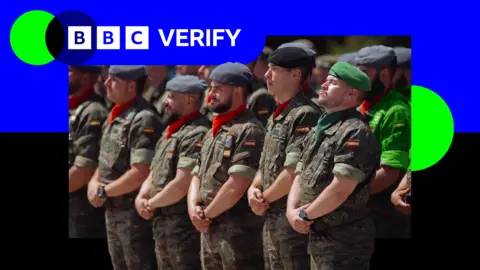Why Trump is targeting Spain over Nato spending
 BBC
BBCNato leaders including President Trump and Prime Minister Keir Starmer are meeting to agree a big increase in defence spending, but nearly a third of the alliance's members have not reached the existing spending target.
The new target will be to spend 5% of the size of their economies, measured by GDP, on "core defence" along with defence-related areas such as security.
But the latest Nato estimates show nine members spent less than the existing target of 2% of GDP.
Trump has been critical of the lowest spender, Spain which he called "notorious" for its "low spending".
Rachel Ellehuus, director of the defence think tank Rusi sees evidence of a spending split within Nato, along geographical lines.
"It's the allies who are closer to the threat from Russia in the north and the east of the alliance who are spending more and as we get down to southern allies, the spending tends to go to 2%, if not lower," she told BBC News.
What can Nato do about low spenders?
The 2% target is not legally binding. There is not an international court that defaulting nations can be taken to.
That means it is mainly down to political pressure, which has come strongly from President Trump, who claimed to have told a Nato leader he would not protect a nation behind on its payments, and would "encourage" the aggressors to "do whatever the hell they want".
"Nobody wants to be called a bad ally for failing to meet the target," Jamie Shea, a former Nato official now working for the Chatham House think tank told BBC Verify.
There are signs that the pressure is working. Even though not all countries have met the 2% level, all of them still managed to increase their spending between 2014 and 2024.
And because some Nato countries ended up below the target and some above it, the overall spending for Nato members, excluding the US, has increased from 1.4% of GDP in 2014 to 2% in 2024.
'Incompatible with our world view'
Spain was the lowest spender in Nato last year, with spending of 1.2%, according to the alliance's estimates.
Prime Minister Pedro Sánchez has said his country will pass 2% in 2025 but there have been demonstrations against higher defence spending.
 Getty Images
Getty Images"Over the last 10 to 15 years we felt we didn't need armed forces - we saw their role as more about natural disaster response, but didn't see the point of having a lot of fighter jets," Mario Saavedra, diplomatic correspondent for El Periódico told BBC Verify.
"But things are now changing very fast. Pedro Sanchez said by the end of the year he will get to 2.1% and he didn't pay a political price for that."
Now Sánchez claims to have been granted an exemption from increasing spending to the proposed 5% Nato target, which he has described as "incompatible with our worldview".
"Analysts and diplomats say 2% is acceptable and 5% is crazy," Mr Saavedra said.
"We can spend more on military spending and there is some sort of acceptance in the political arena and in the public, but we won't go that far and that fast."
Trump has described Spain as "a very low payer" and said Spain "has to pay what everybody else has to pay".
Spain is now arguing that there should be more focus on smart procurement instead of the amount of money spent.
"What the Spanish have said is that there's been too much talk about money and not enough about capabilities," Jamie Shea said.
Spain suggested that by wasting less money they could achieve what the alliance wants without such a big increase in spending, he added.
Meeting the target late
While nine countries failed to achieve defence spending of 2% of GDP by the 2024 deadline, many of them including Spain have claimed they will meet it soon.
In Canada, Mark Carney pledged during his successful election campaign that he would hit 2% by 2030 - Canada spent 1.5% in 2024.
But Carney has now said he will meet the target by March next year.
In Belgium, where they spent 1.3% last year, the government said in March that it would spend an extra €4bn (£3.4bn) this year to take the total up to 2%.
Portugal has also announced that it plans to spend 2% this year, four years earlier than it had previously planned. It spent 1.5% last year.
And Italy has said it expects to reach 2% this year, up from 1.5% in 2024.
Nato secretary general Mark Rutte praised Trump for encouraging Nato members to spend more in a message that the president shared on his Truth Social Account.
"Europe is going to pay in a BIG way, as they should, and it will be your win," the message reads.
Which countries spend the most on defence?
In cash terms, the US is by far the biggest spender on defence in Nato, spending $935bn (£686bn) in 2024, which was 3.2% of its GDP and nearly double the defence spending of the rest of Nato put together.
US spending as a share of its economy has fallen since 2014, when it was 3.7%.
On that measure, Poland was the biggest spender at 4.1% in 2024, followed by Estonia and Latvia on 3.4%.
Additional reporting by Tom Edgington

